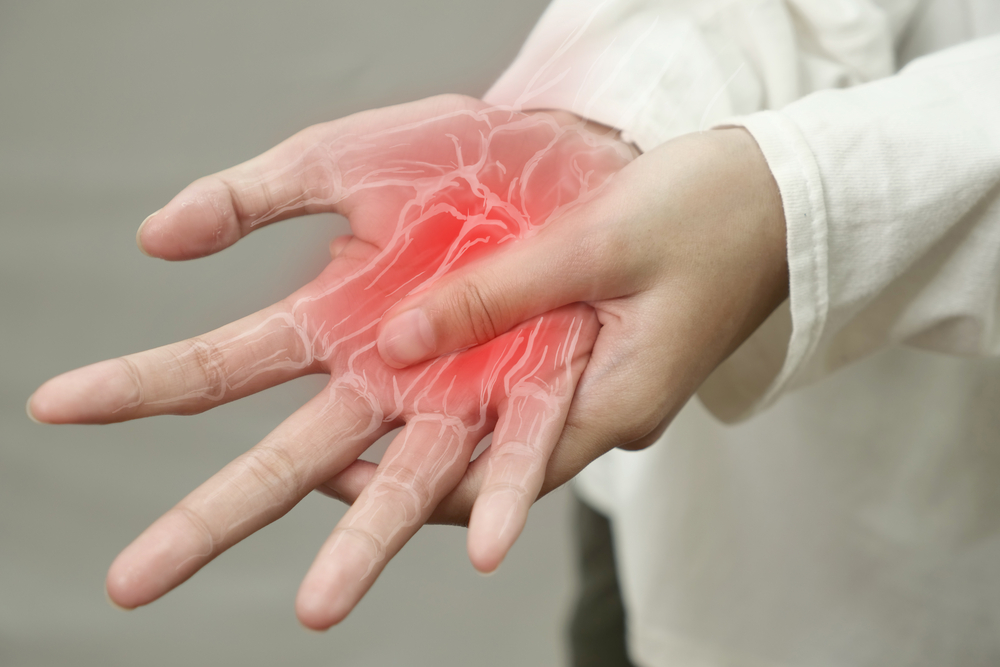
Trigger Finger Treatment in Philadelphia
Trigger finger, or stenosing tenosynovitis, manifests when inflammation affects the flexor tendons, leading to the development of nodules and constriction in the affected finger or thumb. This condition is notably prevalent in women aged 40-60, and while the exact cause remains unknown, certain factors contribute to its onset. Repetitive hand movements, such as gripping or grasping activities, can strain the tendons, while medical conditions like diabetes and arthritis, along with traumatic injuries, increase susceptibility.

Starting at $750 per treatment

treat trigger finger at meeting point health
The inflammatory response in the flexor tendons triggers the characteristic symptoms, including pain, stiffness, and a triggering sensation during movement. The condition may progress gradually or manifest suddenly, impacting the ability to bend or straighten the finger smoothly. The risk factors and symptoms underscore the need for a comprehensive understanding of trigger finger for effective diagnosis and tailored treatment.
Trigger Finger Symptoms
Trigger Finger Treatment Options
Conventionally, non-surgical approaches are typically the initial focus. These include rest, splinting, and the application of ice or heat to alleviate inflammation. Nonsteroidal anti-inflammatory drugs (NSAIDs) may be prescribed for pain relief, while physical therapy exercises aim to enhance finger and thumb mobility. In cases where conservative measures prove insufficient, corticosteroid injections into the tendon sheath are often considered to reduce inflammation. Surgical intervention, such as percutaneous release or open surgery, becomes an option for severe or persistent cases.
At Meeting Point Health, Dr. Matta’s goal is to help his patients find relief that lasts and keeps them out of the operating room. Each of our patients undergoes a comprehensive medical and physical evaluation to assess for and target the root cause. Then, a treatment plan will be tailored to the exact patient and situation utilizing regenerative therapies that rely on the body’s ability to heal. Some of these treatment modalities are listed below:
Acupuncture with Electrical Stimulation Targets pain relief and improves circulation and reduces inflammation.
Osteopathic Manipulation: Focuses on restoring joint and tissue mobility.
Peptide Therapy: Use of peptides to aid in tissue repair and reduce inflammation.
Platelet Rich Plasma Injections: Harnesses the body’s healing potential with concentrated platelets that are injected under ultrasound into specific points.
Stem Cell Therapy: A cutting edge therapy, still in investigational stages, where undifferentiated stem cells are used in joint/muscle injections and also intravenously to promote tissue healing and regeneration.
Nerve Hydrodissection: Involves injecting fluid and peptides to free up compressed nerves.
Prolotherapy and Prolozone Injections: Stimulate tissue repair and reduce inflammation.
Diet and Lifestyle Changes: Targets underlying systemic causes of inflammation and pain
Prevention and Management of Trigger Finger
While trigger finger cannot always be prevented, certain lifestyle modifications can help reduce the risk of developing this condition. Avoiding repetitive hand motions or activities that involve prolonged gripping can minimize strain on the tendons. Taking regular breaks and practicing good ergonomics can also help prevent overuse injuries. Maintaining a healthy weight and managing chronic medical conditions, such as diabetes or arthritis, may further reduce the risk of trigger finger.
For individuals who have experienced trigger finger, long-term management is essential to prevent recurrence and maintain optimal hand function. Regular hand exercises and stretches can help maintain flexibility and prevent stiffness. It is important to listen to the body and avoid activities that cause discomfort or strain. If symptoms persist or worsen, prompt medical attention should be sought to prevent further complications. By implementing these management strategies, individuals can effectively manage trigger finger and minimize its impact on their daily lives.
Soul-Centered Healthcare As a Catalyst For Change
Many people suffer with undiagnosed or misdiagnosed conditions and simply don’t know what’s wrong with them or what will help. We understand what it’s like to feel trapped in a body that is not working for you! At Meeting Point Health, we find the root cause and use a proven, integrative approach that gets results. As highly trained pioneers in functional and regenerative medicine, we’ve helped thousands of patients take control of their health.
OUR PATIENTS FIND RELIEF HERE
Our Patients Find Relief Here
EXCELLENT
We’re here to answer all of your questions
At Meeting Point, we understand that every condition stems from an imbalance elsewhere in the body. We aim to find and heal that imbalance so you can live a richer, healthier life.
Call to schedule your initial consultation with one of our expert healthcare providers if you’re ready to experience what compassionate, holistic care can do for you.
Does Meeting Point Health accept insurance?
Meeting Point Health does not accept insurance.
Our practitioners and staff fully understand and empathize with the challenges that patients face as they make financial decisions for proper health care. Our practice is very different from a conventional medical practice in many ways, but the time spent with each patient is usually 30-90 minutes. Visits with a physician covered by insurance generally allow for less than 10 minutes in total! Conventional medical practices that take insurance maintain brief office visits and high patient loads for this reason. We cannot provide the expert care that every one of our patients deserves under those circumstances.
Insurance also dictates the types of treatments and order of treatments patients can receive for a particular condition.
Opting out of insurance allows the patient and the doctor to maintain their medical autonomy, which is imperative to ensure you get the right treatment at the right time and the right dose.
How do I get started with Meeting Point Health?
To start your journey to relief, schedule a consultation with our team. During your initial visit, we’ll assess your medical history, perform a thorough evaluation, and develop a customized treatment plan to address your specific needs. Click to schedule a free discovery call with one of our Patient Onboarding Specialists today!

